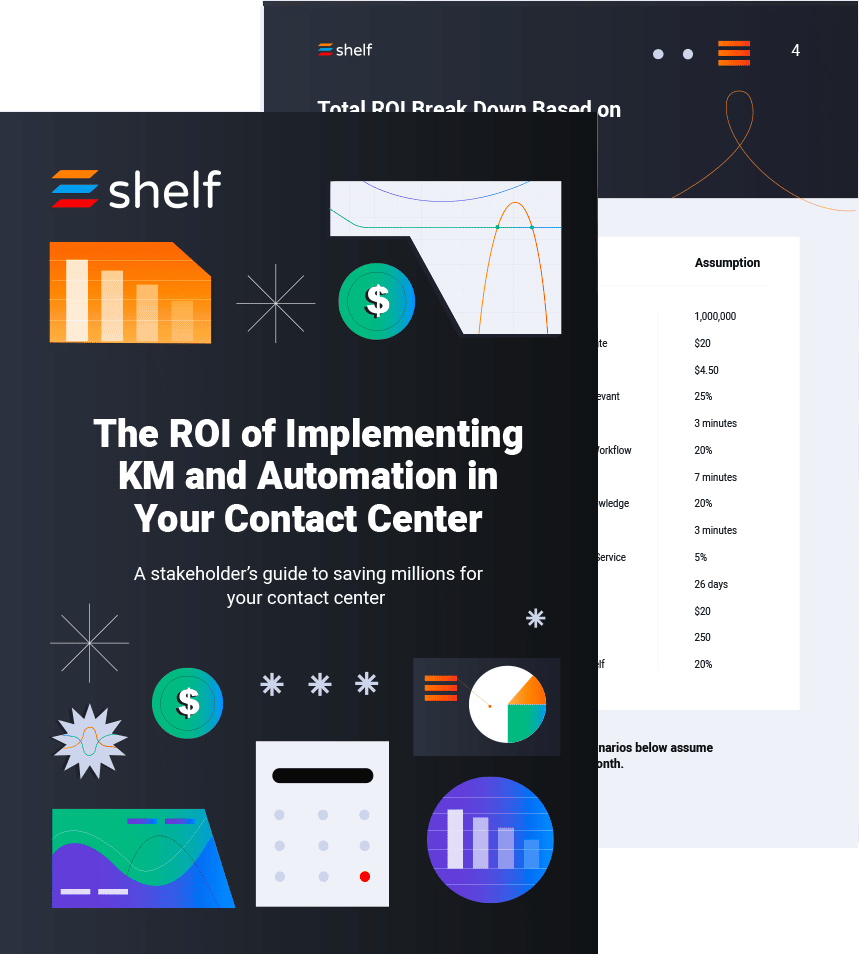How can developing a call center decision tree help your team? Do you know how much time your support team wastes each year finding answers to complex customer questions? Inefficiency costs companies more than you might realize: 516 million hours each year from inefficient software alone according to Freshworks, resulting in 8 billion in lost revenue. Using decision trees can make your call center agents more efficient, and positively impacts metrics like average handle time.
If you don’t know where to begin, don’t worry. In this post, we’ll cover how decision trees work, how your customers and support agents can benefit from them, and practical steps you should take to get started.
Let’s start with the basics.
What is a decision tree for call centers?
A decision tree is a visual content format that takes a series of questions, decisions, and potential outcomes and maps their relationship to one another. Call center teams benefit from decision trees because agents are dynamically presented with the next question to ask, the next step in a process—all based on input from customers.
Decision trees vs. call scripts for call centers
Call scripts differ from decision trees because they don’t account for different scenarios, like if a customer asks a question a script doesn’t cover. Scripts serve a purpose in some contexts, but many call scripts can’t change in real-time based on the conversation, unlike decision trees; scripts are also commonly outdated—particularly paper scripts.
You may still want agents to use a call script as part of a decision tree node for certain scenarios—like if your industry has compliance requirements and agents must repeat a sentence verbatim to a customer.
Pros and cons of call scripting software for call centers
Call scripting software has been on the market for many years, most solutions focus on sentence structure/templates instead of the quality of underlying knowledge used.
Pros of call scripts
- Good for sales or simple support use cases
- Building simple call scripts not dependent on retrieving knowledge
- A/B testing for sales prospecting
Cons of call scripts
- Not ideal for complex customer interactions
- Knowledge can be siloed off in the scripting tool; not part of your knowledge management system
- Difficult for departments to access, maintain, and improve over time
How does a call center decision tree software work?
At a basic level, decision tree software guides a user—like a customer support agent—through a step-by-step process; user input determines the next question or step in the process, and eliminates the need for agents to rely on memory or use complex process documents.
You can create decision tree diagrams using tools like Canva, Lucid Chart or even Excel; decision tree software typically goes beyond static mapping—software dynamically displays the next node in a decision tree based on user input.
Since contact centers deal with thousands of troubleshooting scenarios every day, decision tree software is commonly used in this environment.
Some decision tree solutions are standalone products that require you create a dedicated knowledge base within the tool; many don’t integrate with knowledge bases or customer support tech stacks. If you work for a large company, decision tree ‘software’ is best used as a feature of your knowledge management platform to ensure decision trees are created with the best knowledge and managed effectively—more on that later.
When to use a call center decision tree (and when not to)
You should use decision trees for complex support scenarios, for times support agents must memorize or navigate long, ordered lists; don’t rely on memorization and static lists, especially if errors could lead to compliance headaches.
You shouldn’t use a decision tree if there aren’t enough variables to warrant one—not every question needs a step-by-step diagnosis. If a company sells one product, in one region, with a simple return policy…there’s no need to over-complicate things.
If your support team struggles with a lot of complex processes, there are advantages that make decision trees worth creating. Take a look at these 5.
5 advantages of decision trees in call centers
1. Average Handle Time (AHT) reduction
Decision trees provide information to agents up front, shortening the time it takes to remember the next question to ask—as a result, average handle times decrease. Many agents waste time hunting for a process doc or taking a customer down the wrong path and needing to start over.
Decision trees take the guesswork out of diagnosing a problem.
2. They prevent unnecessary support tier escalation
Your support agents need to exhaust all available information at their disposal, to ask every possible question before escalating the issue. Sure, some questions should be escalated from tier 1 to tier 2, but not all questions.
Agents shouldn’t escalate a simple tier 1 issue because they lost a sticky note or couldn’t remember the next question to ask!
3. More effective support agents, less training time
In today’s contact center, agents shouldn’t have to memorize scripts or rely on documents to be effective. Artificial intelligence surfaces knowledge automatically based on customer intent, decision trees guide agents down the right path for complex troubleshooting.
Information agents need can now be surfaced in real-time thanks to advances in contact center tech like natural language processing and AI-enabled knowledge management platforms. Why require agents to memorize scripts if there’s a better way?
4. Self service channels are more effective
Decision trees help agents, they also help customers self-serve. Many chatbots are hit or miss, with decision tree logic poorly configured, serving wrong information. The right decision tree solution will increase how helpful your chatbots are, and increase the amount of deflections for your support team.
5. Lower risk of agent liability
For some companies, liability becomes a real threat any time customer service provides a wrong answer or skips an important step—willingly or accidentally. For example, in the subscription services market, the FTC ramped up enforcement for businesses that don’t disclose important information, don’t make it easy for customers to cancel services, or don’t obtain informed consent.
If policy compliance is essential for your company, decision trees are a good tool to ensure agents are presented with the right step to take, without any guesswork.
Decision trees and knowledge bases
Decision trees need a good source of knowledge to be effective long-term. The best way to get started with decision tree software is using it as a feature of a knowledge base—preferably a knowledge management platform.
Check out our post on selecting a top KM platform for a breakdown of knowledge management vs knowledge bases, and why a KM platform offers a more complete solution (including features like decision trees).
Most enterprise knowledge management platforms already have integrations with CCaaS solutions, chatbots, IVR systems and other support channels—basically any environment you need step-by-step decision tree prompts to appear. You also ensure decision trees stay maintained and not siloed off if created inside your company’s source of truth for knowledge. Knowledge managers can easily link existing content to decision tree nodes, since assets like images and documents already exist in your library.
Ready to get started with decision trees? Start with knowledge

Ready to transform those static documents into decision trees that save agents time? Start by assessing your knowledge solution. Our team at Shelf will help guide your team through putting decision trees to work inside the environment your support team uses to serve customers.
Shelf’s knowledge management platform allows you to add a decision tree as a content type —just like videos, PDFs, or any other file you add or import, so you can leverage them in all customer interactions.
Schedule a free consultation to chat with us about how we can help you provide better answers to customers using technology like decision trees or watch this short 2-minute Shelf overview video.





